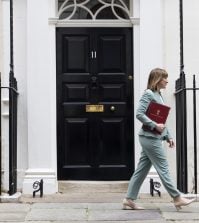Opinion: the public sector will bear the brunt of Sunak’s push to balance the books

The budget suggests that this government believes it is business who will power the UK’s recovery from COVID-19. But it’s a fair bet that departments will end up feeling the squeeze, argues journalist David Walker
The 2021 budget, published yesterday by Chancellor Rishi Sunak, tells the public sector two things. One is that this government believes that it is business who will power the UK recovery out of COVID-19. The second is that there’s trouble ahead for pay and jobs.
It’s clear that Sunak sees the recovery being driven by grants, plus business rates relief, loans to small business and reskilling subsidies. This, even though the medium run forecast puts annual GDP growth by the middle of the decade at under 2%, which is hardly exciting.
So it’s a fair bet that when the books are balanced, public spending will bear a disproportionate share. The same happened in 2010 on the back of the 2008 financial crisis. For the public sector, there’s trouble ahead. If a spending review goes ahead in the autumn, it will have black covers.
Short-term outlook
For the time being, however, nothing much changes for public spending in aggregate or in its distribution between sectors and departments. The status quo holds for education, the NHS and defence with the relative increases announced last year, while the budgets of such departments as Business, Energy and Industrial Strategy (BEIS) and Digital, Culture Media and Sport are barely constant even in cash terms.
Take health out of the total and the spending of a number of departments will go on being squeezed – the Institute for Fiscal Studies think tank suggests Justice among them, while HMRC may struggle to cover the costs of extra staff (1,000 extra for tax enforcement, the chancellor said), despite an extra package from the Treasury.
This is even if the size of the state (measured by total managed expenditure as a share of the economy) will have risen by 2.4 percentage points in 2023 compared with pre-COVID levels in 2018. Of course, that increase has also to pay for the response to both Brexit and Covid and their impact on places and people.
In one sense, this keeping of the status quo is odd. Some people had expected a big announcement on social care – and Labour swooped on its absence in its response to the budget. But not only was Sunak silent, but his framing of the fiscal forecasts implied there is no space for a major increase in public spending. This is despite the ageing population and the need, as demonstrated during the pandemic, for extra provision for the care sector.
Budgets are political statements first and foremost, so a chancellor’s rhetoric is worth a listen too. Sunak dished out praise to the NHS, but he wasn’t exactly fulsome about the public sector at large beyond a mention of some mayors. He did say, however, that the public had trusted the Conservatives on the public sector at the 2019 election.
Ahead lies “corrective action” to stop public borrowing increasing. Sunak also wants to build in “fiscal resilience”, which he said had been boosted by austerity – this was in a part of his speech redacted by HM Treasury as political. This implies even further pressure on public spending. He doesn’t want to frighten the horses quite yet, but in the redacted section he suggested that he wants to cut spending to the level of tax income, in other words for government to stop borrowing to pay for current expenditure. That implies severe retrenchment, though he did not say when.
Levelling up
For now, civil servants are being asked to level up the country, but the budget measures are small scale. Sunak did not, for example, review the geographical distribution of revenue expenditure, focusing instead on investment in infrastructure. It’s true the Infrastructure Bank will be based in Leeds but what proportion of public investment through it – or more generally – will end up in the north? Critics of the programme of spending for road and rail argue that London and the South will remain beneficiaries.
Officials in both central and local government are going to have their work cut out dealing with the expansion of ad hoc grants, including more city deals, going right across Britain even though their value is small in relation to total local expenditure. Academics suggest that the government is intent on “recentralising”, by cutting out the devolved governments in Edinburgh and Cardiff and giving Whitehall renewed leverage over what happens on the ground in Scotland and Wales.
Besides, there’s no question that Sunak sees the recovery being driven by cash grants, tax relief and subsidies to business. Any wider role for the public sector in recovery went unmentioned. Councils have to hope they will be compensated fully for the loss of revenue from business rates, which are going on holiday for several months.
In the meantime, however, money will be found for new office space in Leeds, where the UK Infrastructure Bank will be located and in Darlington, which is to be home to a hub containing numbers of Treasury, BEIS and housing and communities officials. Permanent secretaries’ worries about transport and whether support staff can be found locally have been brushed aside.
Relocating staff to the north of England would not do much to change basic policies, according to think tank the Institute for Government. Real change, the critics say, would only be happening if the Treasury “red book” showed the north’s share of spending rising disproportionately over the long term – that is what levelling up would imply. So far, however, the red book avoids giving a geographical breakdown of spending within England.





















